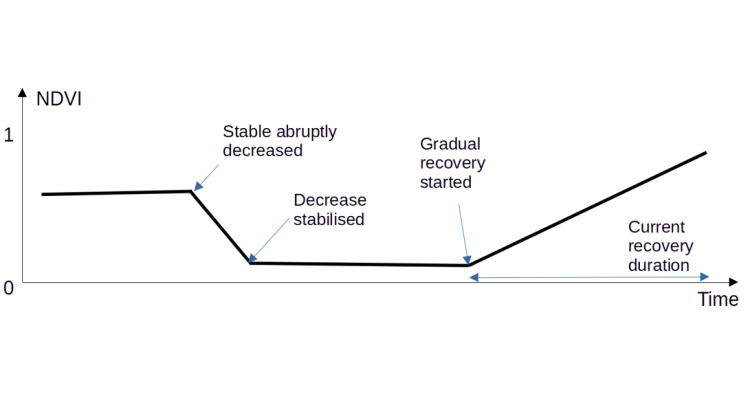
Student information
MSc thesis topic: Automated change detection and classification at a large scale in BFAST Lite
BFAST Lite is a newly developed change detection algorithm based on the established foundation of BFAST (Breaks For Additive Season and Trend) family of unsupervised time series change detection algorithms. It provides more parameters for the users to tune, however, there are opportunities to automate the process of parameter selection to make it easier to use. In addition, it is important to understand its output. The richer output of BFAST Lite has not been studied at a large scale yet. In addition, a means of classifying the typology of each turning point in the time series can be very useful to understand how land cover evolves over time.
The topic can go in three directions, potentially combining several of them in one thesis: 1) Exploring the potential to automate the selection of the harmonic order and/or number of seasonal dummies to better fit the seasonal variation in the input time series. What would be the effect of having these parameters automatically determined for each pixel, rather than preset at the start? 2) The BFAST01 method has the ability to determine the typology of change, i.e. whether the change caused a stable time series to decline, or whether there was already a decline but the change made the decline faster, or whether the change signifies a recovery (rebound). This functionality can be implemented in BFAST Lite to detect the typology of every break in the time series and therefore a typology for the whole time series. Applied at a large scale, it would allow detecting areas undergoing similar change patterns. 3) BFAST Lite provides change magnitude, direction, trend and seasonality information. When the input is land cover (fractions/probabilities), this information can reveal interesting patterns of change. Applying it at the global scale can provide novel insight into land cover change.
Relevance to research/projects at GRS or other groups
The research is part of an ongoing process of improving the BFAST package, which is widely used in a number of fields. For instance, the typology classification is actively being used in several projects by the United Nations Food and Agriculture Organisation (FAO).
Objectives and Research questions
- What is the effect of automatic dynamic seasonality parameter selection in BFAST Lite on output change maps, compared to a preset model for all pixels?
- How do change typology patterns at a global scale differ when applied to all break points in the time series, rather than only the largest break?
- What patterns can BFAST Lite parameter output analysis reveal about global land cover change?
Requirements
- Required: Geoscripting, Remote Sensing
- Optional: Advanced Earth Observation
Literature and information
- Verbesselt, J., Hyndman, R., Newnham, G., & Culvenor, D. (2010). Detecting trend and seasonal changes in satellite image time series. Remote Sensing of Environment, 114(1), 106–115.
- De Jong, R., Verbesselt, J., Zeileis, A., & Schaepman, M. E. (2013). Shifts in Global Vegetation Activity Trends. Remote Sensing, 5(3), Article 3.
Expected reading list before starting the thesis research
- Masiliūnas, D., Tsendbazar, N.-E., Herold, M., & Verbesselt, J. (2021). BFAST Lite: A Lightweight Break Detection Method for Time Series Analysis. Remote Sensing, 13(16), Article 16.
- Bernardino, P. N., Keersmaecker, W. D., Fensholt, R., Verbesselt, J., Somers, B., & Horion, S. (2020). Global-scale characterization of turning points in arid and semi-arid ecosystem functioning. Global Ecology and Biogeography, 29(7), 1230–1245.
Theme(s): Modelling & visualisation, Integrated Land Monitoring